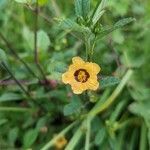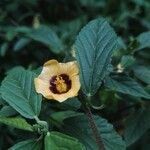Herbs or subshrubs, perennial, often scandent, 0.5–1.5 m. Stems erect or reclining, with simple 1.5–3 mm hairs mixed with shorter stellate hairs, rarely only stellate-hairy. Leaves: stipules free from petiole, 1-veined, subulate, 2–5 mm; petiole 10–30 mm, 1/4–1/2 (to nearly equaling) blade length, pubescence like stem; blade ovate to triangular, 4–9 cm, 1.5–2 times longer than wide, base cordate, margins crenate-serrate or coarsely serrate to base, apex acuminate or attenuate, surfaces sparsely pubescent, abaxial surface stellate-pubescent, adaxial surface stellate-pubescent or with simple, often antrorsely-oriented hairs. Inflorescences axillary, dense, subsessile, 3–8-glabrous or nearly so; mericarps 5, 3 × 1.5 mm, laterally faintly striate to smooth, apex muticous. 2n = 32.
Leaf-lamina up to 7 × 4 cm., cordate-ovate to triangular-cordate, usually acuminate or attenuate at the apex, regularly and acutely serrate, more or less pubescent to strigose-pilose on both surfaces; petiole usually about as long as the lamina, often somewhat abruptly upturned at the apex.
Perennial herb up to c. 60 cm. tall, branched from the base, covered on stems, petioles, pedicels and calyx with hispid to pilose, long-patent to somewhat curly hairs; stems erect or trailing, slender, terete.
Flowers pale yellow or buff, sometimes with reddish centre, in clusters, fasciculate or subcapitate on a short common peduncle, often subsessile; pedicels slender to filiform, up to 12 mm. long.
Mericarps 5, c. 2·5 mm. long, dorsally not reticulated and nearly smooth, laterally faintly flabellately striate, shortly beaked or muticous, somewhat pubescent near the apex.
Calyx 5–7 mm. long, lobed to a little beyond the middle, angular; lobes triangular, attenuate-aristate.
Branches sometimes lax and trailing
Petals c. 9 mm. long, ± emarginate.
Flowers whitish or pale yellow.
A hirsute perennial


